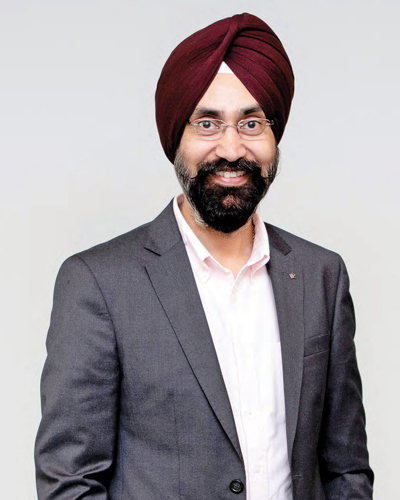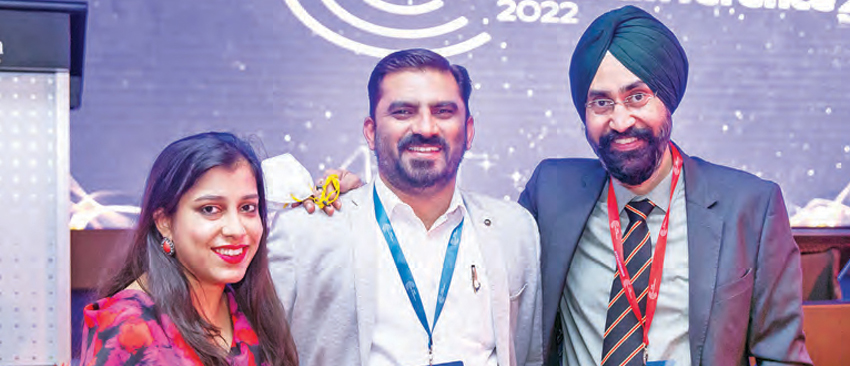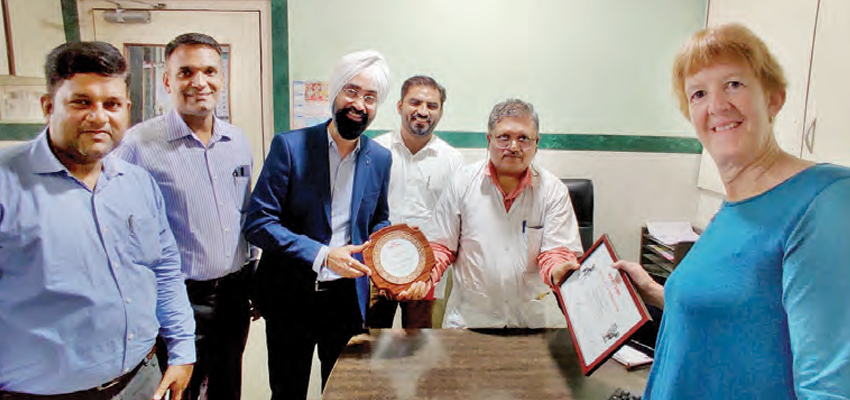Solve a big problem for pet lovers

A new trajectory is on the horizon as the Indian pet care industry, currently estimated at $434 Mn (Retail Sales Value) in 2021, is expected to reach $1356 Mn by 2025. Satinder Singh, General Manager (Managing Director) at Royal Canin, a Mars Inc. division, dwells on the necessity of providing appropriate pet nutritional solutions within the framework of international and Indian regulations. Royal Canin, operates across 100 countries. The Indian subsidiary of the French flagship has been following the company’s import-based supply and distribution model. Corporate Citizen shares insights into India’s pet care market dynamics.

“We don’t follow trends but follow the science. Cats and dogs are the same all over the world; their nutritional requirements are the same; what varies is the geographies and the habitat”, said Satinder Singh, General Manager (Managing Director) at Royal Canin, a division of Mars Inc., which is a family-owned business.
Starting off as Director of Sales and Marketing with Royal Canin in 2016, Satinder Singh has had an array of work experience managing brands, the likes of Frito Lays, Wrigley, PepsiCo-Tropicana Beverages Co, and Mars Petcare before his journey with Royal Canin. He acknowledges the learnings gained from his association with these leading brands that have shaped him professionally and personally. “I think one of the biggest learning from all these companies has been knowing how to create value for consumers. Quality, responsibility, mutuality, efficiency, and freedom are the five principles at Mars Inc. that have guided us in our business or people-related decision-making strategies,” he said.
Royal Canin believes in a united purpose and aims at tangible health benefits through nutrition in the pet care segment. The mission has been to develop pet nutrition through a partnership with pet professionals. Satinder Singh highlights a few nuances of the pet food industry in India. A study indicated that 6 Indians out of 10 own a pet. As per 2021 records, an estimated 28 million dogs and 3 million cats in India are being catered to within the greater community and amongst nuclear family set-ups. An excerpt.
MARKET SCOPE
"The origins lie in science and observation. We continuously seek to innovate our nutrition that positively impacts pet health in improving their lives. Beyond producing precise diets for cats and dogs, we develop and share our knowledge with the greater pet ecosystem"
- Satinder Singh
Corporate Citizen: What is the scope of nutrition in the pet food sector?
Satinder Singh: The power of nutrition lies in providing individualized solutions according to each cat and dog’s breed, size, age, sensitivities, lifestyle, or daily energy need. In other words, the aim is to improve a pet’s quality of life by providing a proper nutritional solution within the framework of international and Indian Regulations.
CC: What are the components of the Indian pet care industry?
The pet care market in India can be broadly classified into 3 groups - food, non-food segment, and services. The food segment includes pre-packaged food, treats, etc., while non-food includes pet accessories, pet grooming products, pet nutraceuticals, beauty, etc. The pet-related service sector comprises professionals including veterinarians, breeders, groomers, handlers, the pet insurance service sector, digital healthcare counselling and the like.
CC: What is the approach of your company in developing pet nutrition?
The origins lie in science and observation. We continuously seek to innovate our nutrition that positively impacts pet health in improving their lives. Beyond producing precise diets for cats and dogs, we develop and share our knowledge with the greater pet ecosystem. The exchange of information is core to who we are as a business, imparting a better understanding of pets and their needs. We also develop various tools and services for pet owners and professionals such as breeders and vets and try to fulfill the more significant objective of becoming their care partners.
CC: How are products developed in partnership with experts?
Animal observation is critical for veterinarians to understand symptoms and guide a diagnosis and how the environment and diet enhance their health and wellbeing. During the development of breed-specific diets, for example, there was feedback from breeders and pet owners of brachycephalic cats and dogs that had difficulty eating classical, round-shaped kibbles. The episode led to designing and testing the optimal shape of kibbles for them. Knowledge is the cornerstone of our science-based approach.
"As an industry leader, we have been playing a role that improves knowledge and awareness of the entire pet ecosystem and goes beyond nutrition. We were actively working via relevant webinars and articles from experts, which reaffirmed our stand on improving the health of canines and cats"
CC: What have been the pet care nutritional/food market transitions in the past decade, especially post-covid?
The pet food industry witnessed a tailwind due to several factors during Covid-19. The number of pet adoptions recorded a sharp increase as people looked for companionship throughout the long months of seclusion during lockdowns and realized pets are the best for companionship. In India, Covid triggered an increase in pet adoption trends and is assumed to stay strong in the next few years.
CC: Who are India’s primary customers in the pet care market?
We work closely with our prescription partners (Veterinarians, Breeders, pet shop owners), key opinion leaders, academicians, other pet professionals, and pet owners on an ongoing basis to exchange ideas and share perspectives. As scientific thought leaders, we facilitate knowledge transfer on health through nutrition.
CC: Why is knowledge transfer essential for the sector?
Our business operates on the “Economics of Mutuality” principle. We strongly believe that a sustainable business relies on shared value created among partners. Gaining and sharing insights from business partners with varied perspectives benefits the entire pet care ecosystem, including pet professionals, pet owners, and ultimately pets, as they are the primary consumers.
HOMING ON PRE-PACKAGED NUTRITION
CC: Why are consumers moving away from homemade pet food to packaged and branded nutrition?
Home-cooked foods allow more control of ingredients and customization to the specific pet, but a qualified veterinary nutritionist does not formulate these food recipes. Home-cooked food could be deficient in multiple essential nutrients and might cause nutritional deficiency diseases in pets. Even when any home-cooked recipe is nutritionally balanced, there is no evidence that the average animal receives better nutrition from it when compared to pre-packaged food. For most pet owners, pre-packaged pet foods offer better nutrition and are convenient and affordable. High-quality pre-packaged pet foods have been tested over decades to provide adequate and balanced nutrition for the dog or cat.
CC: What about the affordability factor for pre-packaged pet food?
Our observation is that many home-prepared diets are costly, time-consuming, and less convenient than pre-packaged pet diets. Several home-prepared diets have the risks of significant nutritional imbalances.
CC: If home-cooked food is better for humans, why not for pets?
Cats and dogs are unlike humans, so home food usually designed for humans is not nutritionally sufficient for pets. Even specially designed home meals for pets are not sufficiently balanced or nutritionally complete. A 2013 study investigated 200 home-prepared diets for dogs and found that over 95% were deficient in one or more of the essential nutrients. The nutritional adequacy of recipes for 67 home-prepared diets for dogs and cats with chronic kidney disease were evaluated and needed assumptions for the preparation of each recipe. The lack of clear instructions likely increased the variability and potentially impacted the nutritional profile of the prepared diet. Combined with problems of nutritional adequacy, it might cause substantial harm to pets when they consume home-cooked diets in the long term.
INDIA-CENTRIC
"Pet humanization, better awareness leading to increased consumption of packaged food, more medical interventions, the convenience of door delivery, and customization are some emerging sector trends globally and in India"
 Satinder Singh cheering the team (Govind Suryawanshi and Garima Mishra) on MTD (Make The Difference)
Satinder Singh cheering the team (Govind Suryawanshi and Garima Mishra) on MTD (Make The Difference)CC: Has there been a change in the consumer demographics in the past 10-15 years?
There has been a change in demographics and pet parenting behaviour over the last decade. Pet humanization is a significant shift, particularly in the metros and urban markets. More pets are considered part of the family, unlike earlier when dogs were primarily “owned” as watchdogs. But today, they are being adopted as part of the family make-up. More younger parents are adopting pets in India (>80% have children less than 6 years old). The metros and urban population are inclined mainly towards adopting cats versus an equal distribution of urban and rural adoption for dogs. Pet adoption increased during Covid, and the trend changed from owning larger dog breeds to smaller breeds, especially in the metros.
CC: Is it possible to calculate the percentage breakup of pet care consumers?
The top 15 cities of India contribute to more than 60% of the pet food market, while Tier 2 and Tier 3 towns are growing equally or even quicker. Regarding pet population trends, the urban population has a greater propensity to adopt cats versus an equal inclination to adopt dogs.
CC: What is India’s market share in the global pet care food /nutrition industry?
India is in its nascent stages compared to the global pet care or nutrition sector, which has a greater awareness of nutrition and the advantages of industrial food, which is currently low amongst Indian pet parents. However, digitalization has been aiding this category in India. The Indian pet care market has become one of the fastest-growing markets, with an estimated CAGR of 17% in the forecast period (2018-2024). Consumer behaviour indicates pet owners visiting vets regularly and becoming informed pet parents. The transition has just begun and is expected to accelerate further with pet health awareness and care improvement.
COMPETING IN THE MARKET
CC: Is there a boom in the pet care market in India?
Yes, there is a boom in the Indian pet care market, especially in the last two years; the market has seen a significant spike. With a 15% CAGR growth in pet adoptions during the pandemic, the pet care industry in India has been growing at 14% annually. Due to the Covid-19 pandemic and the lockdown, people felt the need for a companion, and pets have become the companions of choice. With the increase in the number of pets, the need for pet care and pet food has seen similar growth and could be one of the key reasons why the pet care industry has seen a demand in sales.
CC: What about consumer behaviour with pet products?
Currently, India is the fastest-growing pet care market in the world. A reason for this boom could be attributed to the growing awareness amongst pet parents in their inclination towards visiting the veterinary clinic or seeking appropriate type of diet for their pets. The changing pet-centric mindset has led owners to make more informed decisions.
CC: Who are the prime players in the Indian pet food market?
Pedigree & Whiskas, Royal Canin, Drools, Farmina N&D, Purina and Glenands
CC: What is Royal Canin’s share in the Indian and global pet food market?
Royal Canin enjoys a 15% share of the pet food market in India. Globally, it is a minor player.
CC: Who are your direct competitors in the Indian market?
The biggest competition is home food—95 percent of calories are still consumed through home food.
CC: What factors would you attribute to the uptake in the pet care market?
The pet adoption rate has seen a sharp rise because of rising disposable income, home confinement, and increased awareness of the benefits of pet adoption concerning health, companionship, and pet humanization that have contributed to the rise in adoption of pets. A covid-induced rise in pet ownership and growing consumer awareness led to increased demand for pet products ranging from pet treats to packaged foods.
MARKET DYNAMICS
"The challenges faced are due to a highly ambiguous regulatory environment, isolated government policies focused on livestock and cattle feed, the absence of a uniform regulatory framework and guidelines, and a higher taxation slab on pet food compared to cattle feed. The absence of a single nodal authority adds to the difficulties"
 Satinder Singh and Sylvia Burbery felicitating Dr Rajiv Gaikwad of Bombay Veterinary College
Satinder Singh and Sylvia Burbery felicitating Dr Rajiv Gaikwad of Bombay Veterinary CollegeCC: How challenging is building a lucrative pet care market in India?
There are several factors, but lack of awareness amongst pet parents has been impacting the sector’s growth. They lack knowledge about the right amount of nutrition for their pets, where to adopt a pet, the care that goes with owning a pet, the necessary vaccination schedule, and the importance of sterilization. Although the knowledge has been increasing, it has not reached the desired level. Once the parents know the kind and amount of food that must be given to their pets, there is a good chance that you will see a surge in the industry.
CC: What about government interventions to boost the industry stakes?
The absence of a regulatory framework for the pet food industry is yet another challenge. The government has a few isolated policies in place but focuses on livestock and animal feed. Currently, there is a heavy tax on pet food. Relaxation on the tax component would be a good step in accelerating the growth of the pet care industry.
CC: How can pet food companies build awareness amongst pet owners?
As an industry leader, we have been playing a role that improves knowledge and awareness of the entire pet ecosystem and goes beyond nutrition. We were actively working via relevant webinars and articles from experts, which reaffirmed our stand on improving the health of canines and cats. We believe that once the parents are better informed, they will automatically adapt the right kind of food and open up further growth for the industry.
CC: Do government policies favour the Indian pet care industry?
There is a lack of regulatory framework for the pet food sector. A framework for human food could unlock huge potential in the pet food sector. The challenges faced are due to a highly ambiguous regulatory environment, isolated government policies focused on livestock and cattle feed, the absence of a uniform regulatory framework and guidelines, and a higher taxation slab on pet food compared to cattle feed. The absence of a single nodal authority adds to the difficulties.
CC: Has the PHD Chamber’s initiative urging the government to include Pet Food Industry as a part of the Performance Linked Incentive (PLI) scheme been fulfilled?
No, Not Yet.
CC: How does PLI impact the sector?
The benefits of the PLI scheme are directly linked to the sector’s upliftment and growth to unleash the full potential of the pet food industry.
CC: What is the current growth rate of the sector in India and its expected growth potential?
The current growth rate of the sector is around 15%, and it is expected to grow at a similar pace in the next 5 years. The Indian pet care industry is $434 Mn (Retail Sales Value) as of 2021 and is expected to reach $1356 Mn by 2025.
GLOBAL DIVERSIONS
CC: Has the Ukraine war impacted procuring raw materials for pet food ingredients?
As an industry, we are facing unparalleled pressure on input costs, ranging from the raw materials used in our precise formulas and packaging to transportation and energy costs. The highly volatile global supply chain has been compounded, gradually recovering from the impacts of the global pandemic while simultaneously weathering the implications of geopolitical developments in our region. These factors are certainly not unique to Royal Canin, but we are among the many impacted by these external pressures as a business.
CC: What are the emerging trends likely to be seen in this industry - globally and in India?
Pet humanization, better awareness leading to increased consumption of packaged food, more medical interventions, the convenience of door delivery, and customization are some emerging sector trends globally and in India.
CC: Is there a likelihood of pet care supermarkets in India?
There is a clear possibility of pet supermarkets being more of a one-stop shop for the pet industry in India.